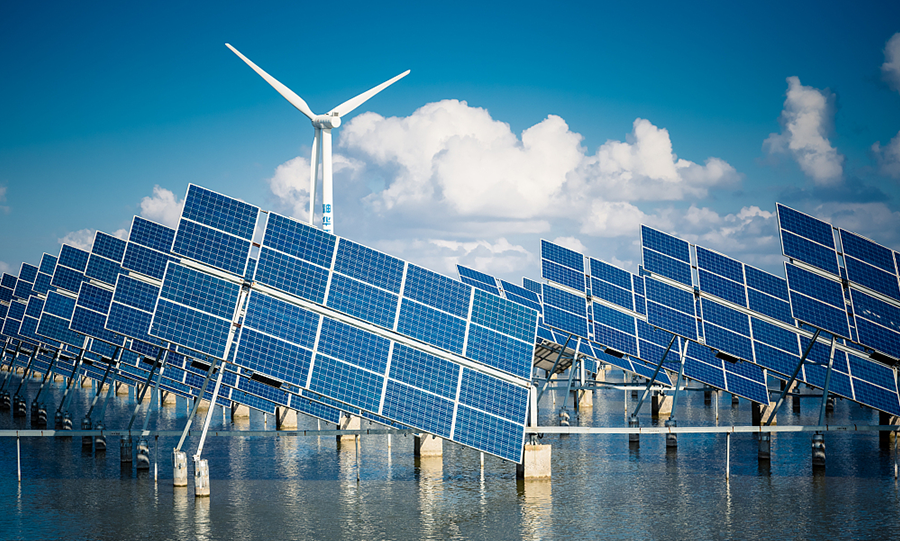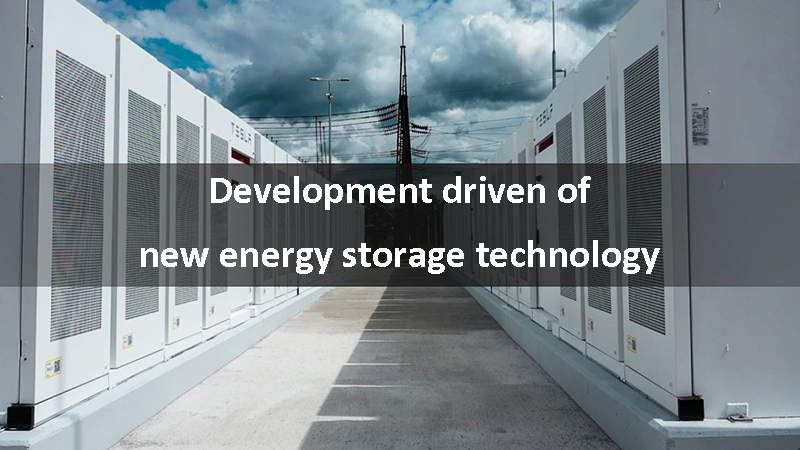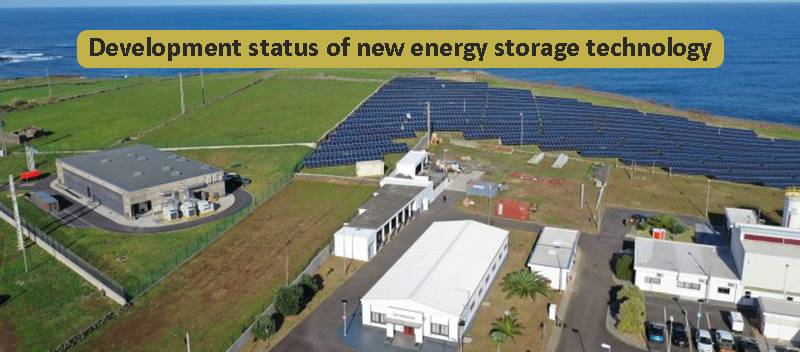
Main content:
Energy storage can effectively solve the contradiction between the intermittent supply of new energy and the continuity of users' electricity demand, realize peak and frequency regulation of the power system, smooth user demand, improve energy utilization, and help achieve the "dual carbon" goal.
Due to its advantages of short construction period and flexible location selection, new energy storage has attracted the attention of the Chinese government and related enterprises. The new energy storage technology has achieved continuous breakthroughs, the industrial ecological vitality has burst, the profit model is clear, and the development prospects are broad.
1. Introduction of energy storage technology
Energy storage refers to the process of storing energy through a medium and releasing it when it is needed. According to different storage media, energy storage can be divided into electric energy storage, thermal energy storage, and hydrogen energy storage. Electric energy storage is the most widely used form of energy storage at this stage. Electric energy storage technology can be divided into electrochemical energy storage, mechanical energy storage.
Electrochemistry includes lithium-ion batteries, sodium-sulfur batteries, lead-carbon batteries, vanadium flow batteries, etc.; Mechanical energy storage includes pumped storage, compressed air storage, flywheel energy storage, supercapacitor storage, etc. Among them, pumped storage started early in development and has a large scale of application. It is a relatively traditional energy storage technology. The new energy storage technology refers to electric energy storage technology, thermal energy storage, hydrogen energy storage, etc. in addition to pumped storage energy.

2. Development driven of new energy storage technology
① Demand driven
The power generation output of energy is misaligned with the peak demand, and the allocation and storage can cut the peak and fill the valley, and smooth the demand. The steady recovery of the economy is the underlying driving force for the growth of China's electricity demand. The construction of high-energy-consuming infrastructure such as 5G will further drive the demand for electricity, and new energy represented by wind power and photovoltaics is becoming the main force in the power system. Since 2010, China's new energy installed capacity has continued to rise, reaching 63,741MW in 2021, with a CAGR of 32.1% from 2010 to 2021.
The proportion of new energy installed capacity in China's total installed capacity has steadily increased year by year, reaching 26.7% in 2021. It is predicted that the proportion will reach 41% in 2030. Compared with conventional power sources, new energy power generation units have small capacity, large number, scattered distribution points, and are greatly affected by external environments such as seasons and weather, and have obvious intermittent, fluctuating and random characteristics. In terms of time distribution, there is a big difference between the output of new energy and the load of electricity.
For example, wind power generally has a large output at night, but the electricity load is small at this time; the output of photovoltaic power generation exceeds the demand or consumption capacity of the power system at noon, and decreases rapidly in the evening, but at this time, the actual electricity load is ushering in the evening peak. The new energy storage technology can realize energy transfer, charge when the grid load is low and discharge at the peak load, reduce the peak load, fill the valley of power generation, promote the consumption of renewable energy, and effectively reduce the rate of curtailment of wind and solar energy.
② Technology driven
The advantages of the new energy storage technology are obvious, and the implementation process is constantly advancing. Compared with pumped hydro, the new energy storage technology has a short construction period, simple and flexible site selection, strong adjustment ability, and better matching with the development and consumption of new energy, and its advantages are gradually becoming more prominent.
The construction period of pumped storage power stations is usually 6 to 8 years, the construction period of electrochemical energy storage projects in new energy storage technologies is 3 to 6 months, and the construction period of new compressed air energy storage projects is generally 1.5 to 2 years. Pumped-storage power stations are often built in places with large terrain differences, but with strong capacity benefits and large single-station scale, they are suitable for large-scale and system-level applications on the grid side.

The new energy storage station can be large or small, has strong environmental adaptability, and has a fast response speed. It can respond in milliseconds to seconds, and can be flexibly deployed in various application scenarios such as power supply, power grid, and user side. In recent years, demonstration projects for the application of new energy storage technology have continued to progress.
In the field of lithium-ion batteries, the lithium iron phosphate energy storage battery built by CATL based on lithium compensation technology has a lifespan of 10,000 times, and has achieved good results in frequency and peak regulation applications in Fujian Province, China. NIO released a new battery pack with a mixed arrangement of ternary cathode electrodes and lithium iron phosphate batteries, which can achieve a 25% reduction in low-temperature battery life loss compared with lithium iron phosphate battery packs, and is expected to be used in large-scale energy storage systems.
In the field of compressed air energy storage, the Chinese Academy of Sciences has built the world's first 10MW salt cavern advanced compressed air energy storage commercial demonstration power station in Shandong. In the field of flywheel energy storage, Foryou Corporation's two single-machine 600 kW full-magnetic levitation flywheel energy storage systems will be used for energy recovery from regenerative braking in Shenzhen Metro.
③ Policy promotion
China's policies at all levels promote the accelerated deployment of new energy storage. China's national-level policy emphasizes the importance of new energy storage in achieving the "dual carbon" goal, and clarifies the development goals of the new energy storage technology industry at each stage, which plays a guiding role in industrial development.
In addition, the governments of Jiangsu, Anhui, Fujian, Hebei and other regions in China have issued mandatory or incentive policies to clarify the allocation and storage ratio of new energy projects such as photovoltaic power generation and wind power, and vigorously guide the development of new energy storage technology.
3. Development status of new energy storage technology
① Technology route
With the parallel development of multiple lines, the application of electrochemical energy storage has progressed rapidly. The energy storage industry as a whole is in a stage of coexistence of various technical routes. Pumped hydro energy storage is the most mature and has the most installed capacity. Electrochemical energy storage is the fastest growing technology among new energy storage technologies.
Different new energy storage technologies can exert optimal energy storage effects in different application scenarios according to their output power, energy density, energy storage capacity, charging and discharging time and other characteristics. Pumped storage and compressed air are suitable for energy storage scenarios for long-term large-scale energy deployment, and are mainly used in large-scale renewable energy grid-connected, grid-side power auxiliary services, etc. to achieve long-term energy management.
The power range of electrochemical energy storage such as lead-acid batteries, flow batteries, and lithium batteries ranges from kilowatts to megawatts, and the discharge time is flexible. It is suitable for short-term grid frequency regulation and energy dispatching and other scenarios. Flywheel and supercapacitor energy storage technology has fast response speed and high flexibility, and is generally used in fields such as emergency uninterrupted power supply. The share of new energy storage technology continues to expand.
According to relevant energy storage industry technology association data, the cumulative installed capacity of new energy storage in China in 2020 will be 3.28GW, and it will reach 5.73GW in 2021, a year-on-year increase of 74.5%. Taking electrochemical energy storage, which accounts for the largest proportion of new energy storage technology, as an example, from 2015 to 2021, the cumulative installed capacity of electrochemical energy storage in China will increase from 0.16GW to 5.51GW, with an average annual growth rate of 80.37%. Compared with the same period, the annual growth rate of cumulative installed capacity of pumped storage is only 9.78%.

Among the new energy storage technologies, the cumulative installed capacity of lithium-ion batteries accounts for 89.7%, which is the most widely used new energy storage technology. China's lithium-ion battery energy storage technology has reached the world's advanced level. In addition, lead batteries account for 5.9%, flow batteries account for 0.9%, flywheel energy storage accounts for 0.1%, compressed air energy storage accounts for 3.2%, and super capacitors account for 0.2%, all of which are in the early stages of application.
② Industrial chain
The new energy storage industry chain has a clear division of labor and a clear profit model. The upstream and downstream of the electrochemical energy storage industry chain, which dominates the new energy storage technology, are clearly defined. The upstream of the industry chain is raw material and equipment suppliers, the midstream is system integrators, installers, and system operators, and the downstream is end users.
Among them, upstream raw materials include cathode and anode electrode materials, electrolytes, diaphragms, structural parts, etc., and equipment includes battery packs, battery management systems (BMS), energy management systems (EMS), and energy storage converters (PCS). According to relevant data, batteries account for the highest proportion of energy storage system costs, reaching 60%, followed by PCS, EMS, and BMS, accounting for 20%, 10%, and 5%, respectively.
Midstream energy storage system integrators integrate energy storage equipment and supporting facilities according to the needs of end users, and design energy storage service systems suitable for various scenarios. Downstream end users include power generation ends such as wind, solar, and traditional power plants, power grid ends such as power grid companies, and user ends such as household users and industrial parks. The revenue model of the new energy storage technology in various application scenarios is relatively clear. The power generation side mainly stores the previously unusable power generation and sells it at the right time to increase power generation revenue and obtain peak shaving subsidies.
The grid side mainly relies on the provision of peak regulation and frequency regulation services to obtain compensation benefits. The industrial and commercial users on the user side can save electricity expenses by installing energy storage, including using energy storage to adjust the electricity consumption during peak and valley different electricity price periods, saving electricity expenses, and reducing the level of installed capacity through energy storage, saving the basic capacity fee for installation. The main profit of household energy storage comes from the price difference between electricity consumption at night and photovoltaic electricity consumption during the day, which increases the self-generated electricity consumption of household photovoltaics and realizes economy.
4. Development trend of new energy storage technology

As the proportion of new energy sources expands, the importance of electrochemical energy storage is further highlighted. The Chinese government and the National Energy Administration issued relevant documents and proposed that by 2025, the proportion of non-fossil energy power generation in China will reach 39%. The proportion of new energy sources continues to expand, and the cost of lithium batteries continues to decrease, driving the continuous expansion of electrochemical energy storage applications.
According to relevant forecasts, the installed capacity of electrochemical energy storage will continue to grow rapidly in the next 10 years, with a compound annual growth rate of 31%. Among them, China, as a large installed capacity of electrochemical energy storage and a pioneer in the energy revolution, the conservative compound growth rate of its cumulative installed capacity of electrochemical energy storage in the next five years will reach 57.4%, and it can reach 70.5% under ideal conditions to achieve true hyper-growth. With the coordinated development of multiple technical routes, advanced compressed air energy storage technology has great potential for development.
In the long run, low cost, high safety and long life are the development trends of new energy storage technology. Advanced compressed air energy storage technology has the advantages of large scale, low cost, long life, clean and pollution-free, unlimited energy storage period, independent of fossil fuels and geographical conditions, etc. It is a long-term energy storage technology with great development potential. It is widely used in power system peak regulation, frequency regulation, phase regulation, rotating backup, black start and other scenarios, and has a large development space and strong competitiveness in improving power system efficiency, safety and economy.
Related article: top 10 home energy storage battery companies, top 5 energy storage BMS companies, solar pv industry
















